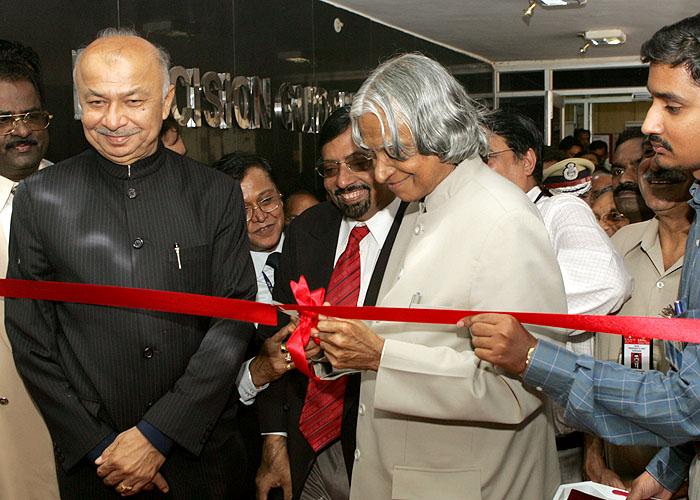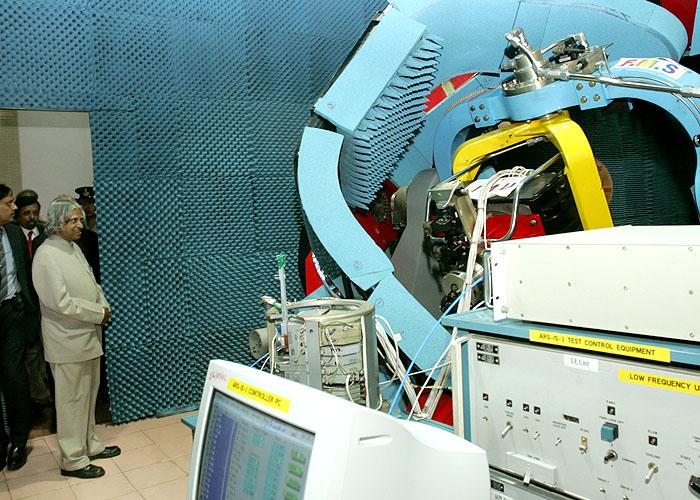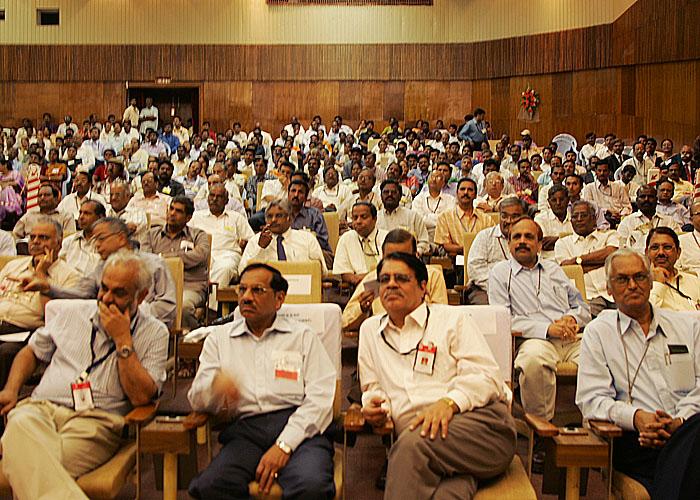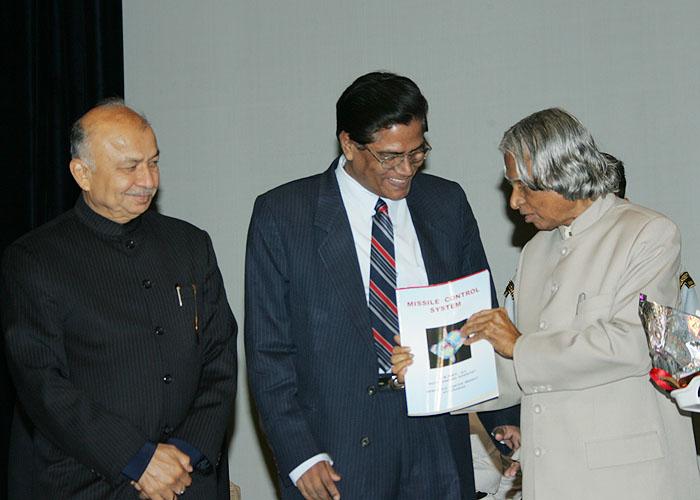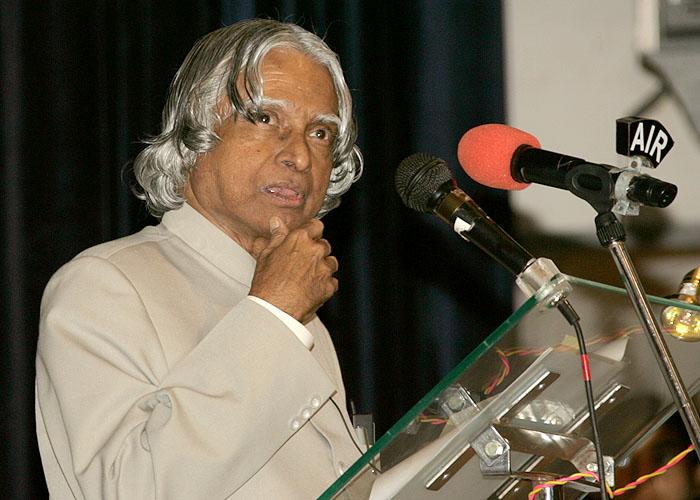Address During the Inauguration of the Advanced Hardware-in-loop Simulation(Hils) Facility at Rci, Hyderabad
Hyderabad : 05-08-2005
I am delighted to be here and participate in the inauguration of Hardware-in-Loop Simulation Facility. I greet the scientist, staff and all the members of RCI on this occasion. The Hardware-in-Loop Simulation Facility is an essential facility required for missile development. Dr. S.K. Choudhry and his team have taken this as a challenge and converted the disadvantage into an opportunity. This has resulted in the availability of the state-of-the-art facility for the missile programme. I would like to discuss with this audience certain thoughts on "converting challenge into opportunity".
In the beginning I would like to talk about how to nurture scientific talents.
Nurturing the talent
I would like to narrate an incident during a function conferring Prof. Norman E Borlaug with Dr. M S Swaminathan Award, at Vigyan Bhavan, New Delhi on the 15th of March 2005. Prof. Borlaug, a Nobel Laureate and a well known agricultural scientist, at the age of 91 was in the midst of all the praise showered on him from everybody gathered there. When his turn came, he got up and highlighted India?s advancement in the agricultural science and production and said that the political visionary Shri C. Subramaniam and Dr. M S Swaminathan were the prime architects of First Green Revolution in India. He also recalled with pride, Dr. Verghese Kurien who ushered White Revolution in India. Then the surprise came. He turned to scientists sitting in the third row, fifth row and eighth row of the audience. He identified Dr. Raja Ram, a wheat specialist, Dr S K Vasal, a maize specialist, Dr. B. R. Barwale, a seed specialist. He said, all these scientists had contributed for your green revolution. Dr. Borlaug introduced them to the audience by asking them to stand and ensured that the audience cheered and greeted the scientists with great enthusiasm. This scene I have not witnessed in our country, so far. This action of Dr. Norman Borlaug, I call it as a Scientific Magnanimity. Friends, if you aspire to achieve great things in life, you need Scientific Magnanimity. It is my experience that great mind and great heart go together. This will motivate the scientific community and nurture team spirit. Here I am reminded of Thiruvalluvar's famous Thirukkural:

It means the right thoughts become the seeds for the great achievements. Now I would like to narrate how to create a vision for the programme.
Igniting the minds for programme thrust
All programmes based on national priority must have a clear vision. On 10 February 2005, three Light Combat Aircraft - Tejas designed developed and produced by Aeronautical Development Agency, Bangalore in partnership with Hindustan Aeronautics Limited, flew as a part of air show of Aero India 2005, after logging 187 flight hours. This incident made me recall the experience and thoughts that I had while witnessing the Paris Air show along with Dr. V.S. Arunachalam the then Scientific Advisor to Raksha Mantri and Dr. Kota Harinarayana, the then Programme Director, ADA and Dr. K. G. Narayanan, Director ADE in the year 1990. It was a beautiful morning, when we were seeing many of the European, American and Russian fighters crossing the sonic barrier and entering supersonic flight speed.
That time, I wrote a verse :
"Let us build our fighter aircraft,
A unique aircraft in its performance,
Which should fly with Indian Flag,
In the Paris Air show".
That was the time the Indian Light Combat Aircraft programme was in the drawing board and in the computer aided design stage with many technological options and managerial conflicts. On 9th February 2005, part of the vision has been realized by flying the three LCAs in the Indian Air Show. We have still to work towards flying our aircraft along with the European, American and Russian fighters in the Paris and other air shows being conducted in different parts of the world. I am sure it will definitely take place. We are very close to such an event. Most important thing is LCA should be inducted into the service and a number of squadrons should become operational with LCA. Next, I would like to narrate about the selection of leaders for the missile programme.
Selection of Project Directors for the Missile Programme
In June 1983 the Integrated Guided Missile Development Programme was about to be sanctioned. That was the time when we had to select the Project Directors for Prithvi, Agni, Akash, Trishul and Nag. In DRDL, at that time, many experienced Scientists were competing for this task. Many of them were over fifty. To enable selection of the most suitable candidate for heading these projects we followed a novel procedure. I called for a meeting of the Management Council of DRDL and the agenda for the meeting was to finalise the criteria required for the selection of the Project Directors. I asked each member of the Management Council to go to the board and write one characteristics, which he considered essential for selection of Project Director. The characteristics mentioned by the members for an effective Project Director were as follows:
a. should be a post-graduate or a doctorate in rocket technology or system engineering.
b. should have achieved excellence in any one of the technology in missile area or in management.
c. should preferably be a good missile system designer.
d. should be a team person.
e. should be a good leader.
f. should be able to get along well with the team, and other agencies contributing to the programme.
g. should have minimum ten years of service left so that the Project Director can see that the missiles are developed and successfully led to production.
h. should be a person of unimpeachable integrity.
When we discussed all the characteristics together, there was convergence among members that the following are the most essential characteristics of the Project Directors: credibility of the person in achieving excellence in one of the technologies or management is the first essential quality. Secondly, Project Director should be young enough to design and develop the missile and lead it to production. Thirdly, the selected candidate should be a person of unimpeachable integrity. With these criteria Scientists of the age group below 40 became the obvious choice for becoming the Project Directors of the Programme. Simultaneously, I nominated the other experienced Senior Scientists as Technology Directors with the responsibility of developing the technologies required by the projects. This created a technological link between the Project and Technology Directors. Project Directors had the sanctioning power, which created a healthy relationship between the Project Directors and the Technology Directors.
As an anecdote to this, I would like to mention how we decided on the name of the projects. In a special meeting we invited all the Project Directors and Technology Directors to decide on the names. We put the criteria that the name should be indicative of the performance of the missile systems; it should be simple, there should be an Indian-ness about the name and should be familiar to every one. On this basis the names Agni, Prithvi, Trishul, Akash and Nag were chosen and today these names have become household names in many places. People at large, common man and even high school students are aware of these names and know what type of missiles these names indicate. Finally I would like to tell you in detail how we succeeded in managing technology denial after the 1998 event when India became a nuclear weapon State.
Technology denial management
In the year 1992, LCA team decided to go for Digital-Fly-by-Wire Control System (FCS) for the Combat Aircraft as it is an unstable aircraft. At that time, the country did not have the experience in developing FCS. The only two countries who had the experience were France and US. The French company (Dassault System) had expertise in Hybrid systems whereas our need was an all Digital-Fly-by-Wire. Hence, it was thought appropriate to have a US partner who has the capability in design, development and integration of FCS on fighter aircraft. There were three candidates, General Electric Control that later became LMCS (now called BAe systems), Lear Astronics and Bendix. Finally, we chose LMCS for the contract since they had the experience in designing FCS for F-16 Aircraft. Joint Team for design and development of the FCS was formed with ADE and LMCS. The work share between Indian team and LMCS team was identified. Evolution of the SRS was the joint effort. The prototype flight control computer was to be done by ADE. Total system integration was the joint responsibility. Flight certification was to be provided by LMCS.
The contract progressed though a bit slowly between 1992-98. Then, as you all are aware, India carried out its nuclear test on 11th May 1998. As soon as this event occurred the American Government imposed technological sanction. Due to the sanction, LMCS broke the contract and retained all the Indian equipment, software and the technical information which were in their premises.
This was definitely a shock for the Indian team. Immediately, I called for a meeting of Directors of ADA, NAL, ADE, CAIR, HAL, National Flight Test Centre, Prof I.G. Sharma, a renowned control system specialist, Prof TK Ghoshal, a noted digital control system expert and guidance and control specialists from DRDL and ISRO. The FCS team explained to these members the situation arising out of the unilateral termination of contract by LMCS. We had a full day discussion on the methodology, which now needs to be followed, by which we can successfully complete the development of digital fly wire system and fly the LCA. The team, after prolonged deliberations, gave a structured method by which the development can be completed and the system can be certified for flight trials. They also mentioned that they will support the programme in whatever capacity they have to work with the ADE and ADA teams.
Based on the recommendations of the specialists we immediately strengthened the ADE software team with additional ten experienced software engineers from ADA. ADA was given the responsibility of verification and validation of software. Integrated flight control system review committee was constituted with Director ADE as Chairman and PGD ADA as Co-chair to support development and resolve all the conflicts arising between Control Law Team, Iron Bird, Software, Hardware and simulation. This team met once a week and brought out all the issues arising in different work centres and solutions were found. In addition, an Iron Bird review team was formed with Project Director Flight Control System as Chairman with members from HAL, ADA, ADE, certification agency (CEMILAC) and Test Pilots from National Flight Test Centre as Members. This team also met every week and resolved all the problems arising in the development and Test on Iron Bird. We also introduced participation of certification agency (CEMILAC) and inspection agency (CRE) in all these reviews. The aim was to see that any problem in any system is brought into focus at the earliest so that the solution can be found. In addition, we made it a point to have a special agenda in the monthly Technical Committee meeting on the development of integrated flight control system wherein Director ADE, Director NAL, Director, National Flight Test Centre, General Manager HAL, presented the progress and problems. The confidence building took place by intensifying the tests. For example, informal Iron Bird test was carried out over thousand hours and the formal Iron Bird test was conducted over hundred and fifty hours. Similarly, Pilot flew the simulator for more than two thousand hours. Thus, what we missed from the foreign partner, we compensated by enhancing the critical design review and increasing the test time to ensure safe man rated design of the integrated flight control system.
The entire team took the denial as a national challenge. They said if it were going to take three years we would do it in two years. If it is going to take twenty million dollars we will do it in ten million dollars. Our working hours was not eight hours. We worked twenty-four hours a day and completed the task. That was the time I realized the power of Indian Scientific Community, and the power of our country. I realized that no country could dominate us by imposing technological sanction or economic sanction. The power of scientific team will defeat the petty designs of any nation. Today, I can proudly say that our scientists have designed, developed, tested, evaluated, and integrated the Integrated Flight Control System in the LCA, which has logged more than 388 trouble free flight sorties in three different aircraft. The challenge of the development is that the aircraft of this class is being designed for the first time; we introduced the state-of-the-art digital fly by wire technology in the very first prototype, which is unstable. We on our own developed the final hardware and software required for testing and evaluation of the control system in the aircraft, after the foreign partner leaves the scene and our own certification team which had no experience in certifying fly by wire aircraft, gains confidence and certifies the aircraft as flight worthy. Above all, the pilots who have never flown a prototype, which is unstable with a fly by wire system confidently, flew the aircrafts based on their flying experience in the simulator and the Iron Bird. Honest self-assessment, identification of area of uncertainty and all out effort to solve the problem were an important aspect of this programme. Integrating strength of industry, R&D Labs, academic institutions and Indian Air Force helped to achieve what was perceived to be an impossible task. This is a demonstration of the Indian that "we will win".
Conclusion : Indomitable spirit
For success in any mission what we need is indomitable spirit. Let us study the characteristics of indomitable spirit. It has two components. The first component is that there must be a Vision leading to higher goals of achievement. I would like to recall a couplet from Thirukkural by the Poet Saint Thiruvalluvar written 2500 years ago. Quote:

It means that whatever may be the depth of the river or lake or pond, whatever may be the condition of the water, the lilly flower always comes out and blossoms. Similarly, if there is a definite determination to achieve a goal even if it is impossible to achieve, the man succeeds.
Many of us have gone through large programmes and projects. We would have experienced that success is not in sight and there are many hurdles. The same poet reminds us at this point of time through another couplet:

We should never be defeated by any problems. We should become master of the situation and defeat the problems. I consider these two Thirukkurals characterize the indomitable spirit.
My best wishes to all the members of RCI for success in their mission of making RCI a centre of excellence in missile development.
May God bless you.

